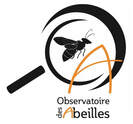Revue d'Hyménoptérologie
Journal of Hymenopterology
ISSN 2727-3806
ARTICLE |
La nouvelle classification des abeilles (Hymenoptera, Apoidea, Apiformes) ou la chute de l’abeille mellifère (Apis mellifera L.) de son piédestal
|
Denis Michez
|
Citation
Michez, D. (2007). La nouvelle classification des abeilles (Hymenoptera, Apoidea, Apiformes) ou la chute de l'abeille mellifère (Apis mellifera L.) de son piédestal. Osmia, 1: 23-26. https://doi.org/10.47446/OSMIA1.7
Published (online) January 2007
Indexation • Archivage - Archiving
Résumé
Dans cet article, l'auteur réalise une synthèse historique des vues sur la classification et la phylogénie des Abeilles. De récents travaux suggèrent la paraphylie des Melittidae et leur position basale dans l'arbre des Abeilles, remettant en cause la classification de Michener (1944, 2000) et le positionnement classique des Apidae - dont l'abeille mellifère Apis mellifera (L.).
Mots-clefs
phylogénie, évolution, paraphylie, monophylie, groupe basal
Title (translation)
The new classification of bees (Hymenoptera, Apoidea, Apiformes) or the fall of the honey bee (Apis mellifera L.) from its pedestal
Abstract
In this article, the author provides a historical review of classification and phylogeny of bees. Recent work suggests the paraphyly of Melittidae and their basal position in the bee tree, questioning the classification of Michener (1944, 2000) and the classic position of Apidae - including the honey bee Apis mellifera (L.).
Keywords
phylogeny, evolution, paraphyly, monophyly, basal group
Références - References
Michez, D. (2007). La nouvelle classification des abeilles (Hymenoptera, Apoidea, Apiformes) ou la chute de l'abeille mellifère (Apis mellifera L.) de son piédestal. Osmia, 1: 23-26. https://doi.org/10.47446/OSMIA1.7
Published (online) January 2007
Indexation • Archivage - Archiving
- DOI: https://doi.org/10.47446/OSMIA1.7
- Zoobank (ICZN): http://zoobank.org/F58DCA1B-C494-472A-9F0D-613B64C59FAD
- HAL (CNRS-INRAE): https://hal.archives-ouvertes.fr/hal-02967243
- Zenodo (CERN): https://zenodo.org/record/4319251
Résumé
Dans cet article, l'auteur réalise une synthèse historique des vues sur la classification et la phylogénie des Abeilles. De récents travaux suggèrent la paraphylie des Melittidae et leur position basale dans l'arbre des Abeilles, remettant en cause la classification de Michener (1944, 2000) et le positionnement classique des Apidae - dont l'abeille mellifère Apis mellifera (L.).
Mots-clefs
phylogénie, évolution, paraphylie, monophylie, groupe basal
Title (translation)
The new classification of bees (Hymenoptera, Apoidea, Apiformes) or the fall of the honey bee (Apis mellifera L.) from its pedestal
Abstract
In this article, the author provides a historical review of classification and phylogeny of bees. Recent work suggests the paraphyly of Melittidae and their basal position in the bee tree, questioning the classification of Michener (1944, 2000) and the classic position of Apidae - including the honey bee Apis mellifera (L.).
Keywords
phylogeny, evolution, paraphyly, monophyly, basal group
Références - References
- d’Aguilar J, 2006. Histoire de l'entomologie. Delachaux et Niestlé, Paris, 224 p.
- Alexander BA, 1992. An exploratory analysis of cladistic relationships within the superfamily Apoidea, with special reference to sphecid wasps (Hymenoptera). Journal of Hymenoptera Research 1: 25-61. https://biostor.org/reference/514
- Alexander BA & Michener CD, 1995. Phylogenetic studies of the families of short-tongued bees (Hymenoptera : Apoidea). The University of Kansas Science Bulletin 55: 377-424.
- Danforth BN, Fang J & Sipes SD, 2006a. Analysis of family- level relationships in bees (Hymenoptera: Apiformes) using 28S and two previously unexplored nuclear genes: CAD and RNA polymerase II. Molecular Phylogenetics and Evolution 39 (2): 358-372. doi.org/10.1016/j.ympev.2005.09.022
- Danforth BN, Sipes SD, Fang J & Brady SG, 2006b. The history of early bee diversification based on five genes plus morphology. Proceedings of the National Academy of Sciences of the United States of America 103 (41): 15118-15123. doi.org/10.1073/pnas.0604033103
- Engel MS, 2005. Family-Group Names for Bees (Hymenoptera: Apoidea). American Museum Novitates 3476: 1-33. http://hdl.handle.net/2246/2786
- Gould SJ, 1996. L'éventail du vivant. Seuil, Paris, 320 p.
- Kirby W, 1802. Monographia Apum Angliae. Privately published, Ipswich, vol. 1 : 258p., vol. 2 : 388 p. doi.org/10.5962/bhl.title.10346
- Latreille PA, 1802. Histoire naturelle générale et particulière des Crustacées et des Insectes. Dufart, Paris, 467 p. doi.org/10.5962/bhl.title.15764
- Maeterlinck M, 1901. La vie des abeilles. Editions Tansatlantiques, Laval, 187 p.
- Michener CD, 1944. Comparative external morphology, phylogeny, and classification of the bees (Hymenoptera). Bulletin of the American Museum of Natural History 82: 1-326. http://hdl.handle.net/2246/1272
- Michener CD, 1981. Classification of the bee family Melittidae with a review of species of Meganomiinae. Contribution of the American Entomological Institute 18: 1-135.
- Michener CD, 2000. The bees of the world. The Johns Hopkins University Press, Baltimore, 913 p.
- Michener CD, 2006. The Professional Development of an Entomologist. Annual Review of Entomology 52: 1-15. doi.org/10.1146/annurev.ento.52.110405.091404
- Michener CD & Greenberg L, 1980. Ctenoplectridae and the origin of long-tongued bees. Zoological Journal of the Linnean Society 69: 183-203. doi.org/10.1111/j.1096-3642.1980.tb01122.x
- Michez D, Else GR & Roberts SPM, 2007. Biogeography, floral choices and re-description of Promelitta alboclypeata (Friese 1900) (Hymenoptera, Apoidea, Melittidae). African Entomology 15: 197-203. https://hdl.handle.net/10520/EJC32709
- Michez D, Eardley CD, Kuhlmann M & Patiny S, 2007. Monographic revision of the southern-african bee genus Capicola (Hymenoptera: Apoidea: Melittidae). European Journal of Entomology 104 (2): 311-340. doi.org/10.14411/eje.2007.048
- Michez D & Patiny S, 2005. World revision of the oil-collecting bee genus Macropis Panzer 1809 (Hymenoptera, Apoidea, Melittidae) with a description of a new species from Laos. Annales de la Société entomologique de France (n. s.) 41: 15-28. doi.org/10.1080/00379271.2005.10697439
- Michez D & Patiny S, 2006. Review of the bee genus Eremaphanta Popov 1940 (Hymenoptera: Melittidae), with the description of a new species. Zootaxa 1148: 47-68. doi.org/10.11646/zootaxa.1148.1.3
- Michez D, Patiny S, Rasmont P & Vereecken N, 2006. Phylogeny and floral choices inheritance in bees. Scientific proceeding of IUSSI Congress XV, July 1 – Augustus 4, Washington D.C. (USA): 41-42.
- Michez D, Terzo M & Rasmont P, 2004. Phylogénie, biogéographie et choix floraux des abeilles oligolectiques du genre Dasypoda Latreille 1802 (Hymenoptera, Apoidea, Melittidae). Annales de la Société entomologique de France (n. s.) 40: 421-435. doi.org/10.1080/00379271.2004.10697431
- Radchenko VG & Pesenko YA, 1994. Biology of bees (Hymenoptera, Apoidea). Russian Academy of Sciences, Zoological Institute, St. Petersburg, 331 p.
- Roig-Alsina A & Michener CD, 1993. Studies of the phylogeny and classification of long-tongued bees (Hymenoptera: Apoidea). The University of Kansas Science Bulletin 55: 123-173. doi.org/10.5962/bhl.part.775
- Rozen JG & Mcgingley RJ, 1974. Phylogeny and systematics of Melittidae based on the mature larvae (Insecta, Hymenoptera, Apoidea). American Museum Novitates 2545: 1-31. http://hdl.handle.net/2246/2746
- Schenk A, 1860. Verzeichniss der nassauischen Hymenoptera aculeata mit Hinzufügung der überigen dem Verfasser bekannt gewordenen deutschen Arten. Stettiner Entomologische Zeitung 21: 132-157; 417-419.
- Thomson CG, 1872. Skandinaviens Hymenoptera. Berling, Lund, 286p.










